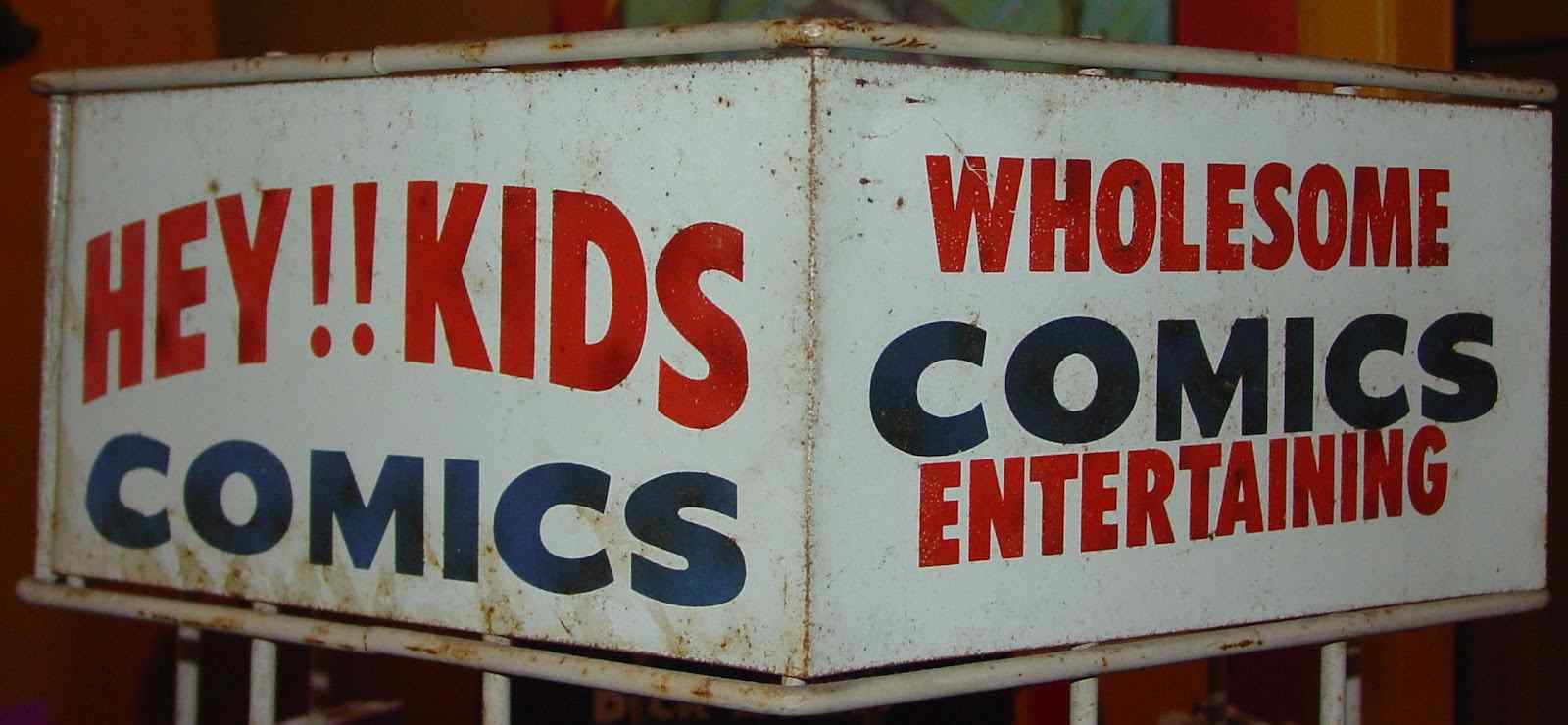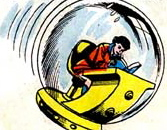 Hey there, bubblenauts, welcome back! After a week off it’s time for another trip into the publishing past of DC Comics. If you’re new to these excursions, you might want to sneak a peek at past trips, when we traveled to:
Hey there, bubblenauts, welcome back! After a week off it’s time for another trip into the publishing past of DC Comics. If you’re new to these excursions, you might want to sneak a peek at past trips, when we traveled to:
• The first week of March, 1952, for the 65th anniversary of the first official Superman/Batman team-up in Superman #76,
• The second week of March, 1977, for the 40th anniversary of Shade, the Changing Man #1,
• The third week of March, 1997, for the 20th anniversary of electric Superman, and,
• The fourth week of March, 1967, for the 50th anniversary of DC’s musical sensation, The Maniaks.
This time out, we again go back 40 years, this time to the first week of April 1977 — 40 years ago this week! — to witness the real origin of the Justice League of America!
The story came smack in the middle of a run by Steve Englehart, who started out in comics as an assistant to Neal Adams in 1971, but soon found his true calling as a writer. For my money, his run on JLA (#139-146, 149-150) stands up to this day as the best version of the Justice League. Ever. For the life of me, I don’t know why DC has not collected these 10 issues into a trade paperback. The scuttlebutt is that DC honchos think fans won’t buy a book of Dick Dillin art. I don’t know if I buy that. Even when as a young boy I was turning up my nose at Kirby, Ditko, and Heck (I’ve since learned the error of my ways) I still loved me some Dillin. I can remember sitting for hours practicing how to draw his version of Red Tornado.
Of course, I may be biased. They say the true Golden Age of Comics is not 1938-1946, it’s 9-12. I don’t think too many 10-year-olds read comics today, but I was 9 years old and among the last generation to buy their comic books directly off the newsstands in the spring of 1977 when JLA #144 landed on the racks at Joe’s Smoke Shop in Waterville, Maine.
Yes, as a 9-year-old I walked two miles from my home in Winslow, across the Kennebec River, to downtown Waterville, where I bought my comics at a smoke shop. What can I say? 1977 was a lo-o-o-o-o-ong time ago. It was a different world.
Anyway, let’s take a look at what I picked up on my trip 40 years ago this week —
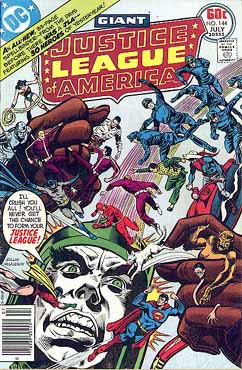
Justice League of America #144 (on-sale April 7, 1977) ©DC Comics
JUSTICE LEAGUE OF AMERICA #144
(on-sale April 7)
“The Origin of the Justice League — Minus One” by Steve Englehart, Dick Dillin and Frank McLaughlin.
The gist of this tale involves Englehart answering that long-burning question of comic book fandom — why was Green Arrow not included as a founding member of the Justice League?
When the JLA made its first appearance in The Brave and the Bold #28 (on-sale Dec. 29, 1959), the team had apparently been operating together for some time. It couldn’t have been that long, of course, because, as many fans today forget, B&B #28 is only the fourth appearance of Hal Jordan!
The Silver Age Green Lantern made his debut in Showcase #22 (July 28, 1959), and the way comics worked at the time, writer Gardner Fox and editor Julius Schwartz must have been at work already on their first JLA tale before having in hand the final sales statistics on the Green Lantern revival. Heck, they must have been nearly done with the book before GL’s third outing, in Showcase #24 (Nov. 25, 1959), even hit stands!
It’s also worth noting that the Silver Age version of The Flash, which first ran on scene in Showcase #4 (July 5, 1956), was only on the seventh issue of his own series (#111, Dec. 22, 1959) following four outings in Showcase. Thus, B&B #28 is also just the 12th appearance of Barry Allen! So, again, it was pretty early into the Silver Age — a term that would not even be coined until a letter from Scott Taylor in JLA #42 (Dec. 9, 1965) — when Schwartz decided that since revivals of Flash and Green Lantern had gone off so well, he might as well try his hand at bringing back the Justice Society of America. Problem is, he didn’t have a lot of costumed heroes to choose from in filling out the team roster.

The Brave and the Bold #28 ©DC Comics
The original JLA, as most who have an interest in a column like this will already know, included Flash, Green Lantern, Wonder Woman, Aquaman, and the Martian Manhunter, along with Superman and Batman. The latter two were not so much associate members, as they had been back in the days of the Justice Society, but their inclusion was limited due to an editorial stance that’s a sharp 180 from today’s super-saturating methodology. Back then it was felt too many appearances by a character would dilute the overall value of the property. But there may have been some interpersonal politics in play at DC as well.
Schwartz and Superman editor Mort Weisinger had known each other since their teen years. They had co-founded The Time Traveller, one of the first science fiction fanzines, as well as Solar Sales Service, the first literary agency for science fiction authors. But Weisinger had always been kind of the junior partner in those enterprises. Now, here they both were at DC Comics, but with Weisinger in charge of Superman, hands down the biggest cash cow the company had.
In The Justice League Companion, a 2005 book from TwoMorrows Publishing, Fox is quoted from a 1977 interview in the fanzine Batmania #22 saying:
“I didn’t use Superman and Batman very much in the first few years of the Justice League [because Superman editor) Mort Weisinger and [Batman editor] Jack Schiff didn’t want us to. They thought I’d overexpose the characters.”
In his 2000 autobiography, Man of Two Worlds: My Life in Science Fiction and Comics, Schwartz recalled that this ban was not lifted until JLA sales started to slip. He met with DC publisher Jack Liebowitz to hammer out a solution and during the conversation mentioned the thou-shalt-not edicts of Messrs. Weisinger & Schiff. As Schwartz told it, Liebowitz barked:
“You go in and tell those sonnuvabitches that Superman and Batman belong to DC Comics and not to Mort Weisinger and Jack Schiff!”

Justice League of America #4 ©DC Comics
Now, all of that is a long way from getting to why Green Arrow was absent from those early JLA adventures. His induction did not come until Justice League of America #4 (Feb. 23, 1961) — 14 months and six issues after the initial JLA adventure!
Apparently, neither Schwartz nor Fox ever gave a direct answer for why Ollie got slighted. The best the Companion book can posit is:
“. . . one might speculate that Schwartz and Fox thought of Green Arrow . . . as a lackluster character. Perhaps the editor and writer anticipated reader expectations of Green Arrow’s membership and held him in reserve to build excitement. Or perhaps they thought that the science-based Manhunter from Mars . . . would better complement the League. Given the science-fiction backgrounds of both Schwartz and Fox, their interest in this extra-terrestrial was not surprising.”
Part of this theory sounds plausible enough. But I sort of doubt that “holding him in reserve” line of reasoning. It’s true, Green Arrow was essentially “Batman with a bow,” and even with limited use of the caped crusader Oliver might well have seemed superfluous alongside scarlet speedsters, emerald gladiators, sea kings, and Amazon warriors.
Still, his exclusion stands out given the relative dearth of options Schwartz and Fox had, short of inventing new characters. Basically, Green Arrow was the only costumed hero DC had at the time who was did not put on the JLA roster! Moreover, he had been around longer than Barry, Hal and J’onn combined, and he was arguably more popular with readers than Wonder Woman.

Adventure Comics #258, “Superboy meets the young Green Arrow.” ©DC Comics
Yes, today we think of the Holy Trinity of DC Comics as being Superman, Batman and Wonder Woman. But in 1959 the Amazing Amazon was appearing only in her own book, and only six times per year. Green Arrow, on the other hand, was appearing monthly in Adventure Comics, and eight times per year in World’s Finest Comics. Yes, for 1959 he had no cover appearances, had not graced a DC cover in fact since More Fun Comics #103 (March 23, 1945), but for the sole exception of Adventure Comics #258 (Jan. 29, 1959) when Superboy met “the young Green Arrow.” So, although Green Arrow had no title of his own and appeared on fewer total comics pages in 1959 than Wonder Woman (129 vs 150), he was the only character besides Superman and Batman holding down a spot in two different magazines, and appeared in more individual stories than any DC hero besides those two.
Personally, I think Schwartz gave Green Arrow a pass as a slight to Weisinger, for being so possessive of Superman. Keep in mind that although for some reason DC today only credits Paul Norris as creator of Aquaman, and nobody on Green Arrow, both characters were originally conceived and written by Weisinger, both making their debuts in More Fun Comics #73 (Sept. 25, 1941). In part because Weisinger kept those characters going after he took over the reins of Adventure Comics, Green Arrow and Aquaman are the only super-heroes outside of DC’s Big Three, from any publisher, to survive all the way from the Golden Age through the Silver Age.
But Schwartz could hardly exclude both of Weisinger’s creations. Given the inability to use Superman or Batman to any great extent, he’d have ended up with a JLA roll call that look more like a Fantastic Four than a Justice League. There just were not a lot of options, short of rebooting other Golden Age characters, and the Justice League was more a proving ground for the updates Schwartz had spearheaded already that a place to try and make lighting strike a third time. The only other really viable character to use would have been Adam Strange, a fact Fox later had The Flash acknowledge when, in JLA #4, the speedster proposed Strange for membership alongside Green Arrow.

Mystery in Space #53, the start of a 40-issue cover run for Adam Strange. ©DC Comics
In fact, Adam Strange might have been a better choice for JLA founding membership than even Green Lantern. As noted above, GL had only made three appearances prior to B&B #28, at least one of which hadn’t even hit stands yet when work must have begun on the first JLA story. But by that time, Adam Strange had already graduated from his own three-issue Showcase tryout to what was, for all intents and purposes, his own title, having taken over Mystery in Space with #53 (on-sale June 4, 1959). So, while it was not his name on the cover logo, Adam Strange had starred in his own book for nearly as long as The Flash. Personally, I’ve never understood why Schwartz moved Strange into MiS and not Strange Adventures, which would have made more titular sense, unless MiS was the lower-selling of the two and could’ve used the boost.
Can you imagine how comics history might have been different if, instead of Flash, Green Lantern, Wonder Woman, Aquaman, and the Martian Manhunter, the founding JLA members had been Flash, GL, and WW, with Green Arrow and Adam Strange?! Might be an Elseworlds story in that, eh?
Be that as it may, Schwartz and Fox passed on the presumably more popular Adam Strange in favor of lesser light J’onn J’onzz, who, while he had been around since Detective Comics #225 (Sept. 29, 1955), had never amounted to more than a six-page backup tale in that title. Meanwhile, Green Arrow was similarly overlooked for Aquaman, who held also-ran status to Superboy and Green Arrow in Adventure Comics. How minor was Aquaman at the time? Well, prior to B&B #28, Aquaman had never appeared on the cover of a DC comic! Today we presume kids of 1959 would have looked at the cover the first JLA story and thought, “What the hell is up with a giant starfish?!” But they might just as well have asked, “Who the hell is the guy in the orange scales?!”
So, again, my theory is that Schwartz, miffed over being denied more extensive use of Superman and Batman — which included an ix-nay on all JLA cover appearances — used the team’s founding line-up as an opportunity to give an editorial middle finger to Weisinger and Schiff. “Can’t use Batman and Superman for fear of over-exposure? Fine. Nothing you can say about the Martian Manhunter and Aquaman, then, is there?” Basically, denied the most popular character each editor had, he skipped over No. 2 in each man’s stable and drew directly from the bottom of the barrel. Perhaps, in addition to testing the popularity of his two new heroes, the new incarnations of Flash and Green Lantern, Schwartz saw the JLA as a way to prove he could also make stars out of the worst dregs Weisinger and Schiff had to offer.
And that brings us to JLA #144 and the the official in-story explanation by Englehart and still-editor Schwartz, 18 years after the fact, for why Green Arrow got passed over for founding-member status in the JLA.

Justice League of America #9. ©DC Comics
When the JLA first appeared in Brave and the Bold, no explanation was necessary. They just were. It was not until two years later, in Justice League of America #9 (Dec. 21, 1961), that an origin story was provided. In that tale, aliens from the planet Appellax come to Earth, having decided that he-who-conquerors it shall be king of their world. Individually, the JLA members defeat each would-be menace, but the final one traps them all one-by-one until, only by working together, they at last prevail. The planet saved, the heroes decide they’ll band together again whenever a threat arises that’s too great for any one alone.
Also, something something, Snapper Carr.
Right from the start, astute readers might wonder why they name themselves the Justice League of America and not the Justice League of Earth. But it was the early 1960s. So, jingoism.
Well, in JLA #144, Englehart has Green Arrow browsing through the JLA satellite archives, because that seems like totally the kind of thing Oliver Queen would do to pass the time. And he discovers a discrepancy. The fight against the Appellaxians is dated February 1960. But Oliver knows Hal Jordan did not become Green Lantern until September of that year. “Hey, What gives!” he wants to know.
A couple of quick points before getting to what gave — Englehart marks the JLA’s founding at one year prior to the cover date (Feb./March), not the actual on-sale date, of the team’s first appearance in B&B #28, while GL’s debut is taken from the cover date (Sept./Oct.) for Showcase #22. Secondly, it seems mighty strange to me that the year 1959 is specifically mentioned. That would have placed the founding of the JLA 18 years in the past, putting most of the members in their mid-to-late 40s, at least! That’s a lot closer at that point to the median age of the Justice Society members than to the Teen Titans, none of whom could possibly have been teenagers any longer. Of course, I was not able to do that math when I was 9 (in truth, I had to use a calculator just now), so it didn’t really matter, I guess.
Anyway, Superman and Green Lantern admit that, as a sly nod to one another, the founding JLA members always dated their first official adventure with the date of their actual first outing as a team. The reason why Green Arrow did not participate? He was busy elsewhere, in the South Seas. We also learn via cameos, as GL and Supes relate the tale at long last, that Adam Strange and Rip Hunter were similarly indisposed — in Adam’s case because he zeta beamed into the body of Congorilla (no, seriously!).
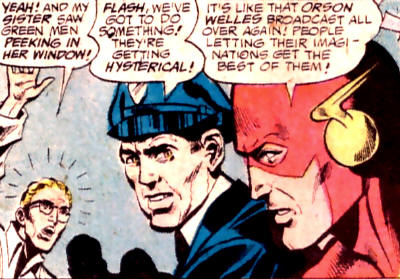 So, what happened? In one of his nascent runs, The Flash came across a White Martian. And, as he knows from his CW team-up with Supergirl, White Martians be scary, yo!
So, what happened? In one of his nascent runs, The Flash came across a White Martian. And, as he knows from his CW team-up with Supergirl, White Martians be scary, yo!
So, he has a bit of a freak out. He puts out a call for heroes to beat back a Martian invasion, which gets picked up and broadcast a la Orson Welles by TV detective Roy Raymond. The result is a mass gathering of every hero operating at the time, as well as everyone who had their own DC title.
Well, I mean, not everyone. It would have been pretty funny, after all, if Jerry Lewis, Bob Hope, and Pat Boone had showed up.
 But answering the call in February 1959 were:
But answering the call in February 1959 were:
• The Blackhawks — who jumped into the DC stable when it purchased the Quality Comics line. They were, in Dec. 1959, on Issue #135 of their own mag.
• The Challengers of the Unknown — then on Issue #7 of their title.
• Lois Lane — having graduated from a two-issue Showcase try-out and then at #8 of her solo book,
• Jimmy Olsen — having by that time bumbled all the way to #36 of his title.
• Congo Bill — along with aforementioned gorilla. Bill first appeared in More Fun Comics #56 (May 2, 1940) and even got his own title, lasting seven issues, in 1954. He had a movie serial, too! So, he was a beg whoop have when jodhpurs were in fashion. He would end his 18-year run in Action Comics with #261, on-sale Dec. 31, 1959 (just two days after B&B #28 came out), before moving over for an 13-issue run in Adventure Comics. At the time of this flashback story in JLA #144 he had not appeared in a DC comic in 12 years, his last outing coming in Superman’s Pal, Jimmy Olsen #86 (May 27, 1965).
• Rex, the Wonder Dog — whose eponymous 46-issue series ended on July 7, 1959. And finally,
• Plastic Man — Also a Quality Comics character, his title has been in reprints for a couple of years when DC bought the company, and he thus failed to make the cut as a continuing series. DC simply canceled the title rather than continue to run reprints or find a new creative team. Plas did get a 10-issue DC run in 1966, but that character was later explained to have been his son.
And then there also were a couple of seemingly odd choices in the crowd, at least for a story set in February 1959. These included:
• Robotman — whose last appearance was in Detective Comics #202 (Oct. 30, 1953), and,
• The Vigilante — not seen since Action Comics #198 (Sept. 29, 1954), excepting only his participation in JLA #100-103, in which he and the other members of the Seven Soldiers of Victory are rescued from time-stasis through the combined efforts of the JLA and JSA. But that was the Earth-2 version. The Earth-1 version first appeared in JLA #78 (Dec. 11, 1969) and just eight other outings prior to this flashback tale, which marks JLA #144 as his earliest chronological appearance.
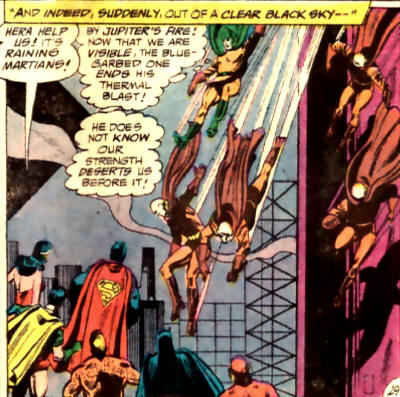 The assembled heroes then split into three teams to track down the martians, but the groupings led by Blackhawk and the Challs run into trouble and it’s the eventual JLA founders who break up the Martian plot, being surprised in the process to find as their prisoner a “good” martian with green skin, named J’onn. They also run into a certain test pilot who will be a part of the team when the heroes meet again against the Appellaxian invaders. Anyway, the heroes save J’onn and all vow to work together again whenever the need arises.
The assembled heroes then split into three teams to track down the martians, but the groupings led by Blackhawk and the Challs run into trouble and it’s the eventual JLA founders who break up the Martian plot, being surprised in the process to find as their prisoner a “good” martian with green skin, named J’onn. They also run into a certain test pilot who will be a part of the team when the heroes meet again against the Appellaxian invaders. Anyway, the heroes save J’onn and all vow to work together again whenever the need arises.
I don’t know if Englehart chose the almost-Leaguers of his own accord, or if he got a directive from Schwartz. At any rate, as with Green Arrow’s absence from the JLA, it’s as much who did not make the cut that interests me.
Roy Raymond, who was then appearing in Detective Comics and would continue to do so until #292 (April 27, 1961) was there, so long underwear was not necessarily a prerequisite. Englehart did do a good job of including just about everyone then published by DC Comics who might’ve answered Flash’s call for help — at least without bending the laws of time and space to respond, as Tommy Tomorrow, Space Ranger, Tomahawk, the Wyoming Kid, and all the western and WWII characters would’ve had to do.
The few who do not factor into JLA #144, who might have in it’s let’s-throw-every-egg-in-the-basket call to arms, include:
• Supergirl — not likely, although I’ve always wondered why she was not included in the Teen Titans, either alongside or instead of Wonder Girl, who only got on the team as the result of an editorial mistake,
• Pow-Wow Smith — then appearing in Western Comics, his adventures were sometimes set in the Old West, but also occasionally in modern times, so he could’ve joined in,
• Mark Merlin — made his debut in House of Secrets #23 (June 18, 1959) just missing the cut, but might’ve been said to have been active as early as February of that year.
• Rick Flag and the Suicide Squad — launched their first mission in Brave and the Bold #25 (June 25, 1959) but, like Merlin, might have answered the call.
However, using the Robotman/Vigilante model, we have a fair number of characters who just missed surviving into the Silver Age who might conceivably have still be active fighting crime in early 1959. Among those possibilities we find:
• Darwin Jones of the Scientific Detective Agency — who appeared irregularly in Strange Adventures as late as #93 (Sept. 25, 1958),
• Doctor Thirteen — who took a hiatus from debunking ghosts as of Star-Spangled Comics #130 (May 21, 1952)
• Johnny Peril — who soldier-of-fortuned until Sensation Mystery #116 (May 20, 1953)
• King Faraday — of the 1950/51 series Danger Trail, who had one final spy thriller in World’s Finest Comics #64 (March 25, 1953), and,
Tuesday, April 5
 JONAH HEX #3 — “The Fugitive” by Michael Fleisher and Jose Luis Garcia-Lopez. Perhaps the most enduring of any DC character who wears his underwear on the inside, Hex was coming off a 29-issue run in All-Star Western, the last 21 of which featured his name as part of the logo. He’d last 92 issues in his own series, all the way to May 30, 1985, then follow that up with 18 issues set in a post-apocalyptic future, before returning to the Old West for three Vertigo limited series between 1993 and 1999. He’d get another 70 issues of his own mag, starting in 2006, then end with his name again co-opting the logo for another 23 issues of a new All-Star Western volume. Add it all up and ol’ Scarface would be on issue #238 if all that had been on continuous series.
JONAH HEX #3 — “The Fugitive” by Michael Fleisher and Jose Luis Garcia-Lopez. Perhaps the most enduring of any DC character who wears his underwear on the inside, Hex was coming off a 29-issue run in All-Star Western, the last 21 of which featured his name as part of the logo. He’d last 92 issues in his own series, all the way to May 30, 1985, then follow that up with 18 issues set in a post-apocalyptic future, before returning to the Old West for three Vertigo limited series between 1993 and 1999. He’d get another 70 issues of his own mag, starting in 2006, then end with his name again co-opting the logo for another 23 issues of a new All-Star Western volume. Add it all up and ol’ Scarface would be on issue #238 if all that had been on continuous series.
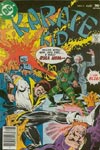 KARATE KID #9 — Princess Projectra guest-starred, as she did a lot, in “The Black Belt Contract” by David Michelinie, Ric Estrada, and Joe Staton. The Legion of Super-Heroes made a few appearances as well as, for the life of me, I don’t know why this had to be set in the 20th century instead of the Kid’s own time. But that’s always the edict with any solo Legion series. This would last 15 issues, getting the ax just shy of the infamous DC Implosion.
KARATE KID #9 — Princess Projectra guest-starred, as she did a lot, in “The Black Belt Contract” by David Michelinie, Ric Estrada, and Joe Staton. The Legion of Super-Heroes made a few appearances as well as, for the life of me, I don’t know why this had to be set in the 20th century instead of the Kid’s own time. But that’s always the edict with any solo Legion series. This would last 15 issues, getting the ax just shy of the infamous DC Implosion.
 THE SECRET SOCIETY OF SUPER-VILLAINS #9 — “Let the Villain Fit the Crime,” by Gerry Conway, Rich Buckler and Bob Layton, may have been my first exposure to Kid Flash, if I remember correctly. I’m pretty sure I discovered him here before Teen Titans, although it would have been a tight race. Regardless, this was definitely the first time I met all the other characters in what would be one of my very favorite titles of the era, even if it only lasted another six issues.
THE SECRET SOCIETY OF SUPER-VILLAINS #9 — “Let the Villain Fit the Crime,” by Gerry Conway, Rich Buckler and Bob Layton, may have been my first exposure to Kid Flash, if I remember correctly. I’m pretty sure I discovered him here before Teen Titans, although it would have been a tight race. Regardless, this was definitely the first time I met all the other characters in what would be one of my very favorite titles of the era, even if it only lasted another six issues.
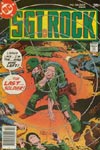 SGT ROCK #306 — Featuring “The Last Soldier” by Robert Kanigher, Joe Kubert and Romeo Tanghal. plus “So Long Buster,” by Kanigher and Estrada. Really, it’s hard to go wrong with Rock and I’m surprised DC has not collected more of this series, which you’d think would sell well in TPB form outside of the usual comic book store distribution chain.
SGT ROCK #306 — Featuring “The Last Soldier” by Robert Kanigher, Joe Kubert and Romeo Tanghal. plus “So Long Buster,” by Kanigher and Estrada. Really, it’s hard to go wrong with Rock and I’m surprised DC has not collected more of this series, which you’d think would sell well in TPB form outside of the usual comic book store distribution chain.
 SUPERMAN #313 — “The Only Way You’ll Save Earth . . . is Over My Dead Body,” by Martin Pasko, Curt Swan, and Dan Adkins, is mostly notable for featuring Nam-Ek, who went on, after relatively few comics book appearances, to greater fame on the Smallville TV show and a cameo in the Man of Steel motion picture.
SUPERMAN #313 — “The Only Way You’ll Save Earth . . . is Over My Dead Body,” by Martin Pasko, Curt Swan, and Dan Adkins, is mostly notable for featuring Nam-Ek, who went on, after relatively few comics book appearances, to greater fame on the Smallville TV show and a cameo in the Man of Steel motion picture.
Thursday, April 7
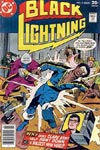 BLACK LIGHTNING #3 — BL is still new to the super-hero came but has “Every Hand Against Him” in this third outing by Tony Isabella, Trevor Von Eeden and Vince Colletta (or at least one of Vinny’s army of assistants). He’d only last 11 issues before the DC Implosion, but you can’t keep a good hero down, and he may soon get his own CW TV show, if the pilot now shooting is any good. It features him coming out of retirement to mentor a daughter he didn’t have at this time though. If it was me, I’d take the TV show back to the character’s roots, as a 1970s period piece with him returning to the slum where he grew up to teach school and fight drugs. Think: Breaking Kotter.
BLACK LIGHTNING #3 — BL is still new to the super-hero came but has “Every Hand Against Him” in this third outing by Tony Isabella, Trevor Von Eeden and Vince Colletta (or at least one of Vinny’s army of assistants). He’d only last 11 issues before the DC Implosion, but you can’t keep a good hero down, and he may soon get his own CW TV show, if the pilot now shooting is any good. It features him coming out of retirement to mentor a daughter he didn’t have at this time though. If it was me, I’d take the TV show back to the character’s roots, as a 1970s period piece with him returning to the slum where he grew up to teach school and fight drugs. Think: Breaking Kotter.
 GHOSTS #55 —Remember when comics didn’t need super-heroes to sell, or even recurring characters? Here’s three ghastly tales with art by Jose Delbo, Frank Redondo, and Noly Panaligan. Even the Grand Comics Database doesn’t know who wrote ’em though. The series would last until #112 on Feb. 4, 1982.
GHOSTS #55 —Remember when comics didn’t need super-heroes to sell, or even recurring characters? Here’s three ghastly tales with art by Jose Delbo, Frank Redondo, and Noly Panaligan. Even the Grand Comics Database doesn’t know who wrote ’em though. The series would last until #112 on Feb. 4, 1982.
And also on sale in April 1977, 40 years ago this month:
Tuesday, April 12
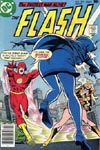 THE FLASH #251 — “Vengeance on Ice,” by Cary Bates, Irv Novick and Joe Giella is just the second appearance of Captain Cold’s kid sister Lisa Snart a.k.a. The Golden Glider. That doesn’t net her any back issue love though. This issue generally sells for $12 in near mint, the same as most issues from this until #276.
THE FLASH #251 — “Vengeance on Ice,” by Cary Bates, Irv Novick and Joe Giella is just the second appearance of Captain Cold’s kid sister Lisa Snart a.k.a. The Golden Glider. That doesn’t net her any back issue love though. This issue generally sells for $12 in near mint, the same as most issues from this until #276.
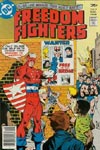 FREEDOM FIGHTERS #9 — “Blitzkrieg at Buffalo” by Bob Rozakis, Dick Ayers and Jack Abel. This was another of my favorite series when I was a kid. This issue was part of an unofficial crossover with Marvel Comics’ The Invaders. In this issue (and the previous one) the FF face off against The Crusaders: Americommando (i.e. Captain America), Rusty (Bucky), Fireball (Human Torch), Sparky (Toro), and Barracuda (Sub-Mariner). Meanwhile, over in Invaders #14-15 (on-sale Nov. 30, 1976, and Jan. 4, 1977, respectively) writer Roy Thomas and the art team of Frank Robbins and Frank Springer pitted their team against The Spirit of ’76 (Uncle Sam), Ghost Girl (Phantom Lady), Captain Wings (Black Condor), Tommy Lightning (The Ray), Thunderfist (Human Bomb) and Dyna-Mite (Doll Man). As a 9 year old, I was in heaven!
FREEDOM FIGHTERS #9 — “Blitzkrieg at Buffalo” by Bob Rozakis, Dick Ayers and Jack Abel. This was another of my favorite series when I was a kid. This issue was part of an unofficial crossover with Marvel Comics’ The Invaders. In this issue (and the previous one) the FF face off against The Crusaders: Americommando (i.e. Captain America), Rusty (Bucky), Fireball (Human Torch), Sparky (Toro), and Barracuda (Sub-Mariner). Meanwhile, over in Invaders #14-15 (on-sale Nov. 30, 1976, and Jan. 4, 1977, respectively) writer Roy Thomas and the art team of Frank Robbins and Frank Springer pitted their team against The Spirit of ’76 (Uncle Sam), Ghost Girl (Phantom Lady), Captain Wings (Black Condor), Tommy Lightning (The Ray), Thunderfist (Human Bomb) and Dyna-Mite (Doll Man). As a 9 year old, I was in heaven!
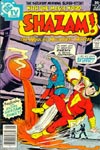 SHAZAM! #30 — “Captain Marvel Fights the Man of Steel,” by E. Nelson Bridwell, Kurt Schaffenberger and Colletta, was an obvious attempt to goose sales for the Big Red Cheese. It doesn’t appear to have worked however, and this title, which was already tending away from the whimsy would close out its 35-issue run with a pair of outings that attempted to cast the Marvel Family a typically contemporary super-hero comic. I think distribution as much as anything may have been what hurt this title though. I have most of the run run, but the final issue was the only one I ever say on the stands when I was a kid.
SHAZAM! #30 — “Captain Marvel Fights the Man of Steel,” by E. Nelson Bridwell, Kurt Schaffenberger and Colletta, was an obvious attempt to goose sales for the Big Red Cheese. It doesn’t appear to have worked however, and this title, which was already tending away from the whimsy would close out its 35-issue run with a pair of outings that attempted to cast the Marvel Family a typically contemporary super-hero comic. I think distribution as much as anything may have been what hurt this title though. I have most of the run run, but the final issue was the only one I ever say on the stands when I was a kid.
Thursday, April 14
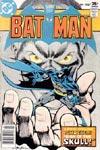 BATMAN #289 — “Sign of the Skull,” by David Vern Reed, Mike Grell and Colletta. An interesting outing for Grell, coming as it does on an off month for The Warlord, bi-monthly at that point and up to issue #7 of its eventual 133-issue run. In my view, the Reed-era Batman run is another uncollected gem from the DC vaults that deserves a TPB, archive, or showcase package.
BATMAN #289 — “Sign of the Skull,” by David Vern Reed, Mike Grell and Colletta. An interesting outing for Grell, coming as it does on an off month for The Warlord, bi-monthly at that point and up to issue #7 of its eventual 133-issue run. In my view, the Reed-era Batman run is another uncollected gem from the DC vaults that deserves a TPB, archive, or showcase package.
 THE HOUSE OF MYSTERY #253 — Just three issues into its short but awesome dollar-size run, which would last until #259, the issue of HoM features stories by Bridwell, John Albano, Doug Moench, Jack C. Harris, Denny O’Neil, Jack Oleck, and Fleisher, with art by Bill Draut, Tony deZuniga, Alex Nino, John Calnan, Gil Kane, Tanghal, Sandy Plunkett, and Quico Redondo, all built around a framing sequence by Paul Kupperberg and Howard Chaykin. Not bad for a buck!
THE HOUSE OF MYSTERY #253 — Just three issues into its short but awesome dollar-size run, which would last until #259, the issue of HoM features stories by Bridwell, John Albano, Doug Moench, Jack C. Harris, Denny O’Neil, Jack Oleck, and Fleisher, with art by Bill Draut, Tony deZuniga, Alex Nino, John Calnan, Gil Kane, Tanghal, Sandy Plunkett, and Quico Redondo, all built around a framing sequence by Paul Kupperberg and Howard Chaykin. Not bad for a buck!
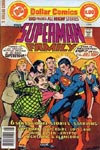 THE SUPERMAN FAMILY #184 — Also three issues into a dollar-size run, this one would last much longer in that format, all the way to series’ end at #222, on June 17, 1982. This issue features 15 pages of Supergirl in “The Visitors from the Void,” by Harris, Delbo, and Colletta; 12 pages of Jimmy Olsen in “The Final Flight,” by Gerry Conway, Schaffenberger and Tex Blaisdell; 7 pages of Krypto in “Bone of Contention,” by Bob Toomey, Calnan and Steve Mitchell; 10 pages of Lois Lane in “Peace of Mind,” by Bill Kunkel, Draut, and Blaisdell, and an untitled 10-page Nightwing and Flamebird tale by Kupperberg, Ken Landgraf, and Tanghal; along with the 8-page cover story, “The Mysterious Misdemeanors of the Prankster,” by Pasko, Schaffenberger, and Robert R. Smith. Again, you got your money’s worth in those days!!
THE SUPERMAN FAMILY #184 — Also three issues into a dollar-size run, this one would last much longer in that format, all the way to series’ end at #222, on June 17, 1982. This issue features 15 pages of Supergirl in “The Visitors from the Void,” by Harris, Delbo, and Colletta; 12 pages of Jimmy Olsen in “The Final Flight,” by Gerry Conway, Schaffenberger and Tex Blaisdell; 7 pages of Krypto in “Bone of Contention,” by Bob Toomey, Calnan and Steve Mitchell; 10 pages of Lois Lane in “Peace of Mind,” by Bill Kunkel, Draut, and Blaisdell, and an untitled 10-page Nightwing and Flamebird tale by Kupperberg, Ken Landgraf, and Tanghal; along with the 8-page cover story, “The Mysterious Misdemeanors of the Prankster,” by Pasko, Schaffenberger, and Robert R. Smith. Again, you got your money’s worth in those days!!
 WEIRD WAR TALES #54 — The Creature Commandoes and G.I. Robot would come in later, but for the longest time Weird War made no effort to ape its Weird Western counterpart by featuring a recurring character. The one-offs in this issue are, “Soldier of Satan,” by Oleck and Abe Ocampo, and “The Traitor,” by Kanigher, Ernie Chan, and Ricardo Villamonte.
WEIRD WAR TALES #54 — The Creature Commandoes and G.I. Robot would come in later, but for the longest time Weird War made no effort to ape its Weird Western counterpart by featuring a recurring character. The one-offs in this issue are, “Soldier of Satan,” by Oleck and Abe Ocampo, and “The Traitor,” by Kanigher, Ernie Chan, and Ricardo Villamonte.
Tuesday, April 19
 OUR FIGHTING FORCES #174 — Featuring The Losers in “Winner Takes — Death,” by Kanigher and George Evans, plus Gunner and Sarge in “An Inch of War” by Kanigher and Cruz. The Losers had owned this title since #123 (Nov. 11, 1969), but for some reason never got the chance to co-opt the title as Sgt. Rock did with Our Army at War and The Unknown Soldier with Star-Spangled War Stories, probably because this was the bottom-seller of the three as in was canceled at #181 (June 8, 1978), with the actual title regaining dominance for the final four issues.
OUR FIGHTING FORCES #174 — Featuring The Losers in “Winner Takes — Death,” by Kanigher and George Evans, plus Gunner and Sarge in “An Inch of War” by Kanigher and Cruz. The Losers had owned this title since #123 (Nov. 11, 1969), but for some reason never got the chance to co-opt the title as Sgt. Rock did with Our Army at War and The Unknown Soldier with Star-Spangled War Stories, probably because this was the bottom-seller of the three as in was canceled at #181 (June 8, 1978), with the actual title regaining dominance for the final four issues.
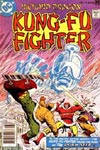 RICHARD DRAGON, KUNG-FU FIGHTER #16 — “The Doom Seer” by O’Neil and Estrada. The real doom, however, came in the form of cancellation, which would hit this title just two issues later, sending Richard Dragon into comic book limbo for decades.
RICHARD DRAGON, KUNG-FU FIGHTER #16 — “The Doom Seer” by O’Neil and Estrada. The real doom, however, came in the form of cancellation, which would hit this title just two issues later, sending Richard Dragon into comic book limbo for decades.
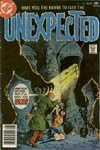 THE UNEXPECTED #180 — Still regular-sized, this book would try the $1 format from #189-196 when it folded in The Witching Hour and The House of Secrets, two bi-monthly titles killed off in the DC Implosion. This issue features, “The Loathsome Lodgers of Nightmare Inn,” by Carl Wessler and long-time Will Eisner assistant Jerry Grandenetti, as well as, “Die Laughing,” by Murray Boltinoff and George Tuska, likewise late of the Eisner studio, as well as, “Death Can Wait,” by Wessler and Franc Reyes.
THE UNEXPECTED #180 — Still regular-sized, this book would try the $1 format from #189-196 when it folded in The Witching Hour and The House of Secrets, two bi-monthly titles killed off in the DC Implosion. This issue features, “The Loathsome Lodgers of Nightmare Inn,” by Carl Wessler and long-time Will Eisner assistant Jerry Grandenetti, as well as, “Die Laughing,” by Murray Boltinoff and George Tuska, likewise late of the Eisner studio, as well as, “Death Can Wait,” by Wessler and Franc Reyes.
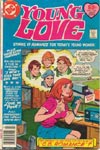 YOUNG LOVE #126 — And here it is, friends, the very final issue of the very last DC romance comic. Shed a tear for the genre that began with Girls’ Love Stories #1 all the way back in 1949! This title actually started out at Prize Publications and was purchased along with Young Romance by DC in 1963, starting its run with a DC bullet gracing its cover at #39. This final love fest features four stories, including one by longtime DC artists Win Mortimer.
YOUNG LOVE #126 — And here it is, friends, the very final issue of the very last DC romance comic. Shed a tear for the genre that began with Girls’ Love Stories #1 all the way back in 1949! This title actually started out at Prize Publications and was purchased along with Young Romance by DC in 1963, starting its run with a DC bullet gracing its cover at #39. This final love fest features four stories, including one by longtime DC artists Win Mortimer.
Thursday, April 21
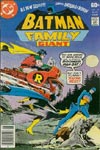 BATMAN FAMILY #12 — Even more than DC’s $1 books, of loved the 60¢ giants of this era. This featured Batgirl (10 pages) in, “I Am Batgirl’s Brother,” by Bob Rozakis, Delbo, and the omnipresent Colletta; Man-Bat (10 pages) in, “Dread Night of the Jaguar,” by Rozakis, Marshall Rogers, and Terry Austin; and the Batgirl and Robin team (12 pages) in, “Rally Round Robin,” by Rozakis, Irv Novick, and Colletta.
BATMAN FAMILY #12 — Even more than DC’s $1 books, of loved the 60¢ giants of this era. This featured Batgirl (10 pages) in, “I Am Batgirl’s Brother,” by Bob Rozakis, Delbo, and the omnipresent Colletta; Man-Bat (10 pages) in, “Dread Night of the Jaguar,” by Rozakis, Marshall Rogers, and Terry Austin; and the Batgirl and Robin team (12 pages) in, “Rally Round Robin,” by Rozakis, Irv Novick, and Colletta.
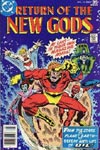 THE NEW GODS #12 — After a five year hiatus from #11, The New Gods return in, “Prelude to a Holocaust,” by Conway, the great Don Newton, and Adkins, featuring Jezebelle, the New God you never heard of! She was a creation on Conway’s considered more or less sacrilegious by all subsequent writers more attuned to the Holy Church of Kirby. This series had the Gods + Jezebelle on Earth working to track down six humans hunted by Darkseid as potential sources of the anti-life equation. I’ll tell you this one also got poor distribution as I don’t recall seeing a single issue of this eight-issue run (it got canceled at #19) on newsstands when I was a kid. Too bad.
THE NEW GODS #12 — After a five year hiatus from #11, The New Gods return in, “Prelude to a Holocaust,” by Conway, the great Don Newton, and Adkins, featuring Jezebelle, the New God you never heard of! She was a creation on Conway’s considered more or less sacrilegious by all subsequent writers more attuned to the Holy Church of Kirby. This series had the Gods + Jezebelle on Earth working to track down six humans hunted by Darkseid as potential sources of the anti-life equation. I’ll tell you this one also got poor distribution as I don’t recall seeing a single issue of this eight-issue run (it got canceled at #19) on newsstands when I was a kid. Too bad.
 SUPERBOY #229 — “Hunt for a Hero-Killer,” by Paul Levitz, James Sherman, and Abel, has the team working to track down the killer of their teammate Chemical King, who got sent to that big Shanghalla in the sky last issue. After #230, the title, which had featured the Legion on the cover since #197 (June 19, 1973), would change officially in the indicia to Superboy and the Legion of Super-Heroes.
SUPERBOY #229 — “Hunt for a Hero-Killer,” by Paul Levitz, James Sherman, and Abel, has the team working to track down the killer of their teammate Chemical King, who got sent to that big Shanghalla in the sky last issue. After #230, the title, which had featured the Legion on the cover since #197 (June 19, 1973), would change officially in the indicia to Superboy and the Legion of Super-Heroes.
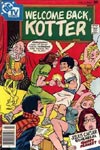 WELCOME BACK, KOTTER #5 — Hey, didn’t I just mention Kotter a bit ago? I bet you didn’t know DC did a Welcome Back, Kotter adaptation did you? No, I don’t know why, either. “Friends! Romans! Sweathogs!” was by Toomey, Estrada and Bob Oksner. This series ran 10 issues, from Aug. 5, 1976 to Dec. 8, 1978. That landed it between Seasons 2 and 3 of the show, which was on the air with 95 first-run episodes from Sept. 8, 1975 to Jun 8, 1979. Luckily, the comic ended before John Travolta’s Vinny Barbarino left and Beauregarde De LaBarre arrived to take his place.
WELCOME BACK, KOTTER #5 — Hey, didn’t I just mention Kotter a bit ago? I bet you didn’t know DC did a Welcome Back, Kotter adaptation did you? No, I don’t know why, either. “Friends! Romans! Sweathogs!” was by Toomey, Estrada and Bob Oksner. This series ran 10 issues, from Aug. 5, 1976 to Dec. 8, 1978. That landed it between Seasons 2 and 3 of the show, which was on the air with 95 first-run episodes from Sept. 8, 1975 to Jun 8, 1979. Luckily, the comic ended before John Travolta’s Vinny Barbarino left and Beauregarde De LaBarre arrived to take his place.
Tuesday, April 26
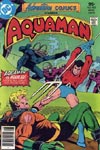 ADVENTURE COMICS #452 — After 11 issues, this would be the last in the current run to feature Adventure stalwart Aquaman, who’d leave after this outing to return once again, if ever so briefly, to his own title. “Dark Destiny, Deadly Dreams,” by Michelinie and the amazing Jim Aparo features the death of Aqua-baby. To my mind, the fact that Aquaman was not only a father, but had lost his son in a tragic accident was something that made Aquaman different from and a little more compelling than all other heroes. It was an aspect of his lore rarely followed up on afterward and later dropped altogether. Heck, he can’t even stay married in current continuity.
ADVENTURE COMICS #452 — After 11 issues, this would be the last in the current run to feature Adventure stalwart Aquaman, who’d leave after this outing to return once again, if ever so briefly, to his own title. “Dark Destiny, Deadly Dreams,” by Michelinie and the amazing Jim Aparo features the death of Aqua-baby. To my mind, the fact that Aquaman was not only a father, but had lost his son in a tragic accident was something that made Aquaman different from and a little more compelling than all other heroes. It was an aspect of his lore rarely followed up on afterward and later dropped altogether. Heck, he can’t even stay married in current continuity.
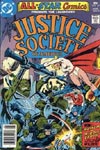 ALL-STAR COMICS #67 — Featuring the Justice Society of America in, “The Attack of the Underlord,” by Levitz, Staton and Layton. I actually own a page of original art from this issue! All-Star was another of my favorite titles of the era — yeah, all my favs died in the Implosion. It was a terrible, scarring experience that haunts me to this day. ::sniff:: I really dug Power Girl, even though she wasn’t sporting the infamous boob window at this time.
ALL-STAR COMICS #67 — Featuring the Justice Society of America in, “The Attack of the Underlord,” by Levitz, Staton and Layton. I actually own a page of original art from this issue! All-Star was another of my favorite titles of the era — yeah, all my favs died in the Implosion. It was a terrible, scarring experience that haunts me to this day. ::sniff:: I really dug Power Girl, even though she wasn’t sporting the infamous boob window at this time.
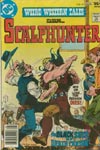 WEIRD WESTERN TALES #41 — It’s the third outing for Scalphunter, who’d rule the logo from his start all the way to series end at #70 (May 22, 1980). “The Black Seer of Death Canyon,” is by Fleisher, Ayers, and Springer. The series would get an Issue #71 in 2010 as part of the Blackest Night event, although, if I recall correctly, that one featured Super-Chief, rather than Scalphunter.
WEIRD WESTERN TALES #41 — It’s the third outing for Scalphunter, who’d rule the logo from his start all the way to series end at #70 (May 22, 1980). “The Black Seer of Death Canyon,” is by Fleisher, Ayers, and Springer. The series would get an Issue #71 in 2010 as part of the Blackest Night event, although, if I recall correctly, that one featured Super-Chief, rather than Scalphunter.
 THE WITCHING HOUR #72 — This title had been around since Dec. 19, 1968, but only had another 13 hours left on the clock after thisish, which contains stories by Wessler and George Kashdan, with art by Cruz, Panaligan, and Ruben Yandoc, who would, of course, go on to greater fame over at Marvel as a member of the Guardians of the Galaxy.
THE WITCHING HOUR #72 — This title had been around since Dec. 19, 1968, but only had another 13 hours left on the clock after thisish, which contains stories by Wessler and George Kashdan, with art by Cruz, Panaligan, and Ruben Yandoc, who would, of course, go on to greater fame over at Marvel as a member of the Guardians of the Galaxy.
Thursday, April 28
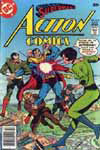 ACTION COMICS #473 — Has Superman in “The Great Phantom Peril,” by Cary Bates, Swan, and Blaisdell. This issue is most famous as the second outing for Kryptonian feminazi Faora Hu-Ul, who is most famous for being the basis of Ursa, of Superman II movie fame.
ACTION COMICS #473 — Has Superman in “The Great Phantom Peril,” by Cary Bates, Swan, and Blaisdell. This issue is most famous as the second outing for Kryptonian feminazi Faora Hu-Ul, who is most famous for being the basis of Ursa, of Superman II movie fame.
 THE BRAVE AND THE BOLD #135 — Save for Issue #72, which featured a Spectre/Flash pairing, B&B had been a Batman team-up book since #67 (on stands June 28, 1966). From that time, Batman starred alongside the Metal Man four times — in #74, 103, 113, and 121 — making this their fifth adventure together. I mean, sheesh, Batman should have been fitted with a response-o-meter at this point, ya think?! “More than Human,” is by Bob Haney and Aparo. Sadly there would only be just two more Batman/Metal Men pairings after this, in #136 and 187.
THE BRAVE AND THE BOLD #135 — Save for Issue #72, which featured a Spectre/Flash pairing, B&B had been a Batman team-up book since #67 (on stands June 28, 1966). From that time, Batman starred alongside the Metal Man four times — in #74, 103, 113, and 121 — making this their fifth adventure together. I mean, sheesh, Batman should have been fitted with a response-o-meter at this point, ya think?! “More than Human,” is by Bob Haney and Aparo. Sadly there would only be just two more Batman/Metal Men pairings after this, in #136 and 187.
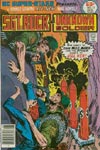 DC SUPER-STARS #15 — features an all-new, and so far as I am aware, only pairing of Sgt. Rock and the Unknown Soldier, in “Heap the Corpses High,” by Kanigher, Lee Elias, and Tanghal. DC Super-Stars was an oddball book, starting as a reprint series, it evolved to feature special one-off events. Issue #3 was one of my first comics featuring the Legion of Super-Heroes, and served to introduce me to the Silver Age and Adult Legion teams almost as soon as I became aware that was such a thing as the Legion to begin with, which probably has a lot to do with why I am so invested in the team to this day. It makes sense that, into its all-new era, DCSS would feature a Rock/Soldier team-up, promoting both characters soon after they formally took over their former anthology titles.
DC SUPER-STARS #15 — features an all-new, and so far as I am aware, only pairing of Sgt. Rock and the Unknown Soldier, in “Heap the Corpses High,” by Kanigher, Lee Elias, and Tanghal. DC Super-Stars was an oddball book, starting as a reprint series, it evolved to feature special one-off events. Issue #3 was one of my first comics featuring the Legion of Super-Heroes, and served to introduce me to the Silver Age and Adult Legion teams almost as soon as I became aware that was such a thing as the Legion to begin with, which probably has a lot to do with why I am so invested in the team to this day. It makes sense that, into its all-new era, DCSS would feature a Rock/Soldier team-up, promoting both characters soon after they formally took over their former anthology titles.
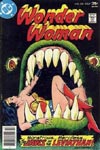 WONDER WOMAN #233 — “Seadeath” by Conway, Don Heck, and Colletta, came during a weird time for Wonder Woman. Because the ABC-TV series was set in World War II, during the first season of the show, from Oct. 13,1976, to Feb. 16, 1977 (as were pre-series specials that aired in Nov. 7, 1975, April 21, 1976, and April 28, 1976), DC altered the comic to feature her Earth-2 counterpart’s WWII adventures. That change was in effect from Issue #229 (Dec. 23, 1976) to #242 (Jan. 31, 1978). But when CBS picked up the TV show for its second season, one of its conditions was that the setting be transported to modern times. That season began on Sept. 16, 1977 and ran to April 21, 1978. So, the continuities of the comic book and the TV show were never quite in sync.
WONDER WOMAN #233 — “Seadeath” by Conway, Don Heck, and Colletta, came during a weird time for Wonder Woman. Because the ABC-TV series was set in World War II, during the first season of the show, from Oct. 13,1976, to Feb. 16, 1977 (as were pre-series specials that aired in Nov. 7, 1975, April 21, 1976, and April 28, 1976), DC altered the comic to feature her Earth-2 counterpart’s WWII adventures. That change was in effect from Issue #229 (Dec. 23, 1976) to #242 (Jan. 31, 1978). But when CBS picked up the TV show for its second season, one of its conditions was that the setting be transported to modern times. That season began on Sept. 16, 1977 and ran to April 21, 1978. So, the continuities of the comic book and the TV show were never quite in sync.
Okay, well, there you have it. That was April 1977 in DC Comics. Sorry, the Time Bubble was rather a lengthy column this time, but, as I noted, the whole 1976-1979 era was my personal Golden Age, so I get a bit chatty. Next time out will be much shorter, as we stop in at the second week of April, 1942 — a month when DC published only 10 comics total — where we will stand witness as Wonder Woman gets her magic lasso!
Until then, remember, “Hey, Kids! COMICS!!
